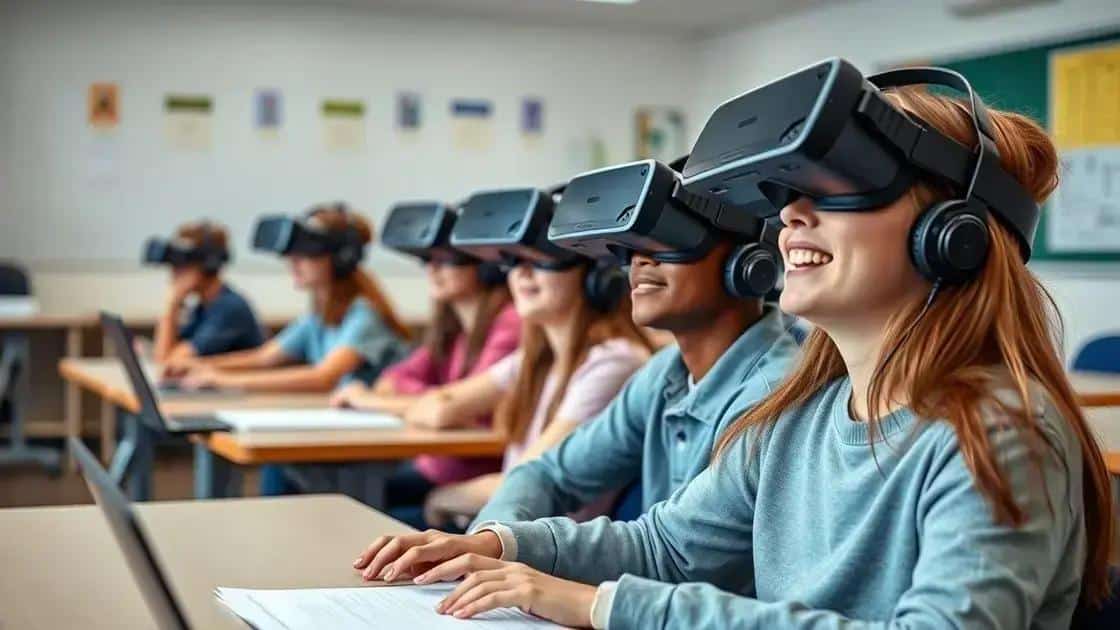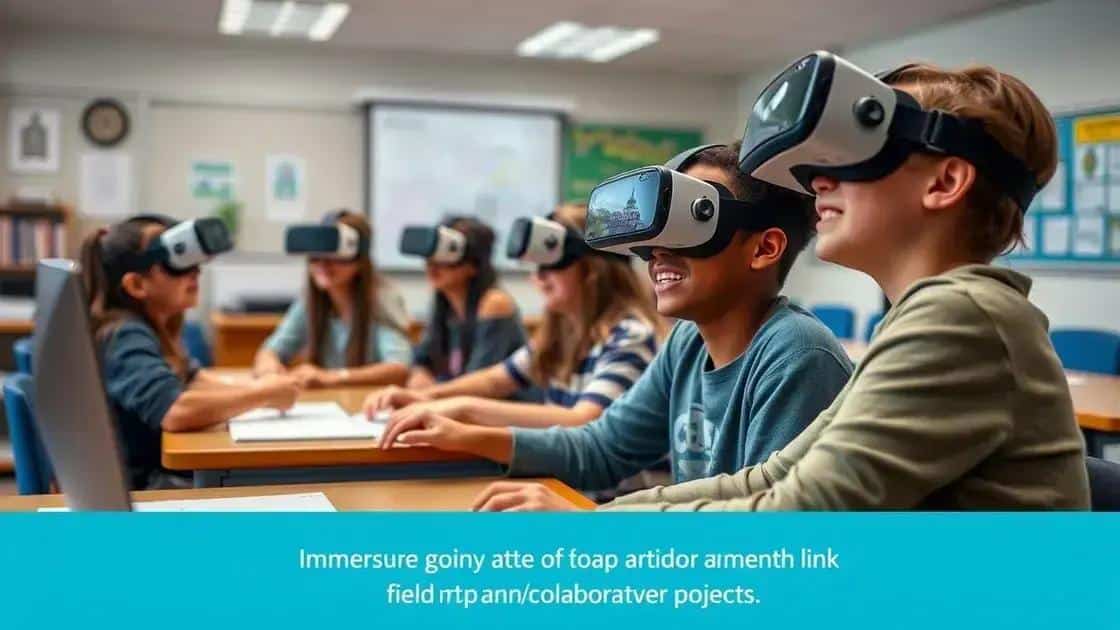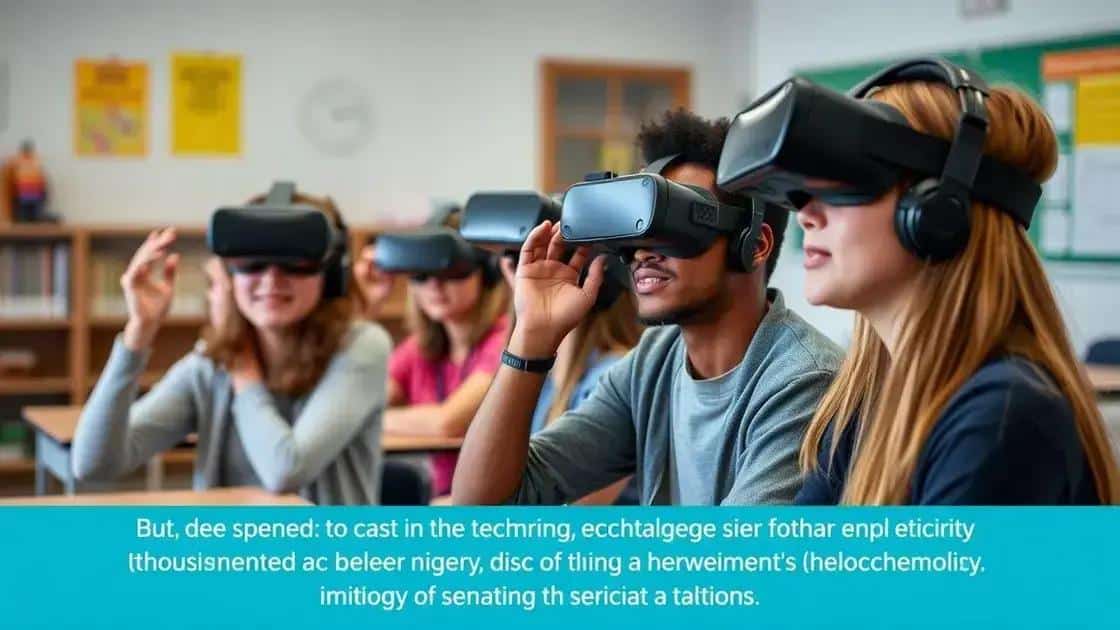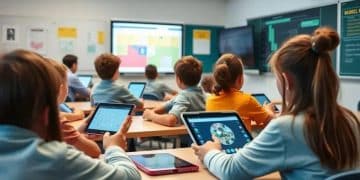Insights on vr learning environments: enhancing education

Insights on VR learning environments highlight their potential to engage students, enhance learning experiences, and foster collaboration, while also addressing challenges like cost, accessibility, and potential discomfort.
Imagine transforming the classroom with Insights on vr learning environments, making lessons come to life in ways we never thought possible. This innovative approach to learning is not just a trend; it’s reshaping how we think about education. Ready to explore its potential?
Understanding the concept of vr learning environments
Understanding the concept of vr learning environments starts with recognizing how virtual reality can transform education. These immersive spaces offer learners the chance to engage deeply with the material, making lessons more interactive and memorable.
What are vr learning environments?
At their core, vr learning environments are simulated spaces created using virtual reality technology. They allow students to explore places and concepts without leaving their classroom. Imagine visiting ancient Rome or exploring the human body—all from your desk!
Benefits of vr learning environments
Incorporating VR into education can lead to numerous advantages:
- Enhanced engagement: Students are more interested in lessons when they can interact with digital environments.
- Safe exploration: VR allows students to experiment and explore without real-world consequences.
- Personalized learning: Each student can learn at their own pace in a virtual setting.
This interactive experience is designed to foster collaboration and creativity. For instance, group projects can take on new dimensions when students can work together in a virtual space. Additionally, this technology can accommodate various learning styles, catering to auditory, visual, and kinesthetic learners.
However, implementing vr learning environments also comes with challenges. Schools need the right technology, training, and support. Teachers must adapt their lesson plans to incorporate VR effectively. While these adjustments may require time and resources, the payoff can be significant.
As technology improves and becomes more accessible, we can expect vr learning environments to become increasingly common in education. With their potential to engage students in innovative ways, the future of learning looks bright.
Benefits of vr in educational settings

The benefits of vr in educational settings are numerous and impactful. Virtual reality offers a unique way to engage students and enhance their learning experiences. When students interact with virtual environments, they can absorb information more effectively.
Increased Engagement
One of the major advantages of using VR is the heightened engagement it brings to the classroom. Students are often more intrigued when they can visualize and experience concepts firsthand. This leads to a deeper connection with the material, making learning more enjoyable and effective.
Safe Learning Environment
Another significant benefit is the capability for safe exploration. In a vr learning environment, students can experiment and solve problems without the risks associated with real-world situations. For example, they can conduct virtual science experiments or practice emergency response techniques.
- Encourages creativity: Students can create and simulate scenarios that foster innovative thinking.
- Real-world applications: VR allows students to practice skills in a realistic context that enhances learning.
- Accessibility: VR makes learning materials more accessible to diverse learners, accommodating different learning styles.
Additionally, VR can promote collaboration among students. They can work together within the same virtual space, discussing and solving problems as a team. This collaborative approach enhances communication skills and teamwork.
It’s also noteworthy that VR can cater to diverse educational needs. From students with learning disabilities to those who are advanced, VR environments can be tailored to meet various learning requirements.
By integrating vr technology into lessons, teachers can create interactive experiences that are memorable and educational. As the technology continues to evolve, the benefits of vr in educational settings will only expand, leading to innovative teaching methods and enriched learning experiences.
Effective strategies for implementing vr technologies
Implementing vr technologies in education requires thoughtful strategies to ensure success. Schools and educators can enhance the learning experience by using VR effectively. Understanding the best practices is essential to maximizing the benefits of virtual reality.
Begin with Clear Goals
Before introducing VR, it’s crucial to set clear learning objectives. Define what you want to achieve, whether it’s enhancing engagement, improving understanding of complex topics, or enabling hands-on practice. Having specific goals will guide the integration of VR into the curriculum.
Integrate with Existing Curriculum
Another effective strategy involves blending VR technology with the current curriculum. Teachers should find ways to incorporate VR experiences that align with existing lessons. For example, a history lesson can include a VR tour of historical events or locations. This integration enhances traditional learning methods and keeps students engaged.
- Provide Training: Ensure educators are trained to use VR tools and understand the technology.
- Start Small: Begin with a pilot program to gauge effectiveness before a full rollout.
- Gather Feedback: Regularly collect student and teacher feedback to make necessary adjustments.
Moreover, schools should invest in quality VR equipment and software. The technology must be accessible and user-friendly to avoid disruptions in the learning process. Teaching staff should feel comfortable using the tools to create immersive experiences.
Another important aspect is to encourage collaboration among students during VR sessions. Team-based activities within virtual environments can foster communication and teamwork skills. This approach builds critical thinking as students solve problems together in a simulated world.
Ongoing support and maintenance for the technology are also essential. A reliable technical support system can address any issues quickly, ensuring minimal disruptions. By being proactive, schools can maintain a smooth learning environment.
As educators continue exploring effective strategies for utilizing VR, the possibilities for enhancing student engagement and learning outcomes are endless. With the right planning and execution, VR can redefine the educational experience for students.
Challenges and considerations for vr in education

There are several challenges and considerations for vr in education that educators and institutions must address. While virtual reality offers exciting opportunities for teaching and learning, it also comes with its own set of challenges that can impact its effectiveness.
Technological Limitations
One of the primary challenges is the technological limitations of VR. Not all schools have access to the necessary equipment or high-speed internet required to support VR experiences. This accessibility issue can create disparities in learning opportunities among students.
Cost of Implementation
Implementing vr technologies can be expensive. Schools need to invest not only in the hardware but also in the software and ongoing maintenance. These costs can be a burden, especially for underfunded institutions.
- Staff Training: Educators may require training to use VR tools effectively, adding to the costs.
- Curriculum Development: Creating VR content that aligns with educational goals can be time-consuming and complex.
- Technical Support: Having reliable tech support is crucial to resolve issues quickly.
Moreover, some students may experience motion sickness or discomfort while using VR headsets. This physical reaction can limit participation and effectiveness of the learning experience. Addressing these concerns is essential to creating an inclusive environment for all learners.
It’s also important to consider the potential for distraction. With VR, it can be easy for students to get lost in the immersive experience rather than focusing on the educational content. Educators need to find a balance between engagement and meaningful learning. They should plan lessons carefully to keep students on track.
Furthermore, educators must continuously evaluate the effectiveness of integrating VR into their teaching. Gathering feedback from students can help identify areas for improvement and ensure that vr in education meets its intended goals.
By recognizing these challenges and considerations, schools can better prepare to implement VR technologies effectively. The key is to address these issues proactively to maximize the benefits of VR while minimizing the drawbacks.
FAQ – Frequently Asked Questions about VR in Education
What are the main benefits of using VR in education?
VR engages students and enhances learning experiences by immersing them in realistic scenarios and promoting active participation.
What challenges do schools face when implementing VR technologies?
Challenges include the high costs, limited access to technology, and the need for training educators to use VR effectively.
How can VR improve student collaboration?
VR allows students to work together in virtual environments, solving problems and completing tasks collectively, which enhances teamwork skills.
Are there any risks associated with using VR in the classroom?
Some students may experience motion sickness or distraction while using VR, so it’s essential to monitor their comfort and focus during lessons.





